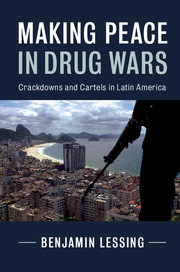Book contents
- Frontmatter
- Dedication
- Contents
- Figures
- Tables
- Preface
- Acknowledgments
- Abbreviations and Acronyms
- 1 Introduction
- PART I A THEORY OF CARTEL–STATE CONFLICT
- PART II CASE STUDIES
- PART III CONDITIONAL REPRESSION AS OUTCOME
- Appendix A Violent-Event Data
- Appendix B List of Interview Subjects
- Bibliography
- Index
- Miscellaneous Endmatter
1 - Introduction
Published online by Cambridge University Press: 17 November 2017
- Frontmatter
- Dedication
- Contents
- Figures
- Tables
- Preface
- Acknowledgments
- Abbreviations and Acronyms
- 1 Introduction
- PART I A THEORY OF CARTEL–STATE CONFLICT
- PART II CASE STUDIES
- PART III CONDITIONAL REPRESSION AS OUTCOME
- Appendix A Violent-Event Data
- Appendix B List of Interview Subjects
- Bibliography
- Index
- Miscellaneous Endmatter
Summary
THE PUZZLE OF CARTEL–STATE CONFLICT
In December 2006, just ten days after his inauguration, Mexican President Felipe Calderón launched a “battle with no quarter” against his country's drug cartels, involving the largest non-humanitarian deployment of Mexico's army in modern times. Calderón's crackdown did not start Mexico's drug war—cartel-related killings had doubled under the previous administration—but it would, he hoped, end it. Whatever political calculations informed his decision, and there were many, Calderón clearly believed that a militarizedcrackdownwouldwork: that it wouldreverse risingdrugviolence, cripple the cartels, exorcise thethoroughgoing corruption that had reigned for decades, and restore public order and the rule of law. It did none of these things.
If trafficking and corruption continued predictably apace over Calderón's six-year term, violence exploded unimaginably. Not even the most vocal critics of his strategy anticipated that the conflict would escalate by an order of magnitude, claiming a staggering 70,000 lives by 2012. Moreover, though the lion's share of these killings were among traffickers, Calderón's tenure saw an equally sharp and unexpected eruption of cartel–state violence. Traffickers invaded police stations, assassinated mayors, blockaded cities, and publicly called on Calderón to withdraw federal troops. Cartel attacks on army troops, once unheard of, became everyday occurrences. Such brazen armed defiance undermined government claims that traffickers were merely exterminating one another, and deepened the sense of crisis and loss of state control that Calderón's crackdown was meant to allay. More than a decade later, cartels’ armed resistance continues.
Mexico is not the only place where militarized crackdowns on cartels led to unexpected anti-state violence. In 1984, Colombian Justice Minister Rodrigo Lara Bonilla launched the first serious offensive against his country's cocaine traffickers, not to curb violence—cartels were then peacefully dividing a wildly lucrative boom in global demand—but to fight corruption. The crackdown triggered not only Lara Bonilla's own assassination but a decade of withering, anti-state “narco-terrorism” and some of the most severe urban violence on record anywhere. Drug lord Pablo Escobar led Colombia's cartels into an overt war on the state—and eventually among each other—that convulsed a nation and, for a time, overshadowed an ongoing civil war.
- Type
- Chapter
- Information
- Making Peace in Drug WarsCrackdowns and Cartels in Latin America, pp. 1 - 34Publisher: Cambridge University PressPrint publication year: 2017

